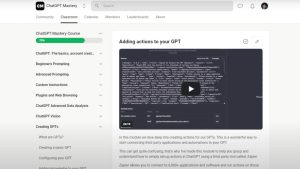With the recent release of the GPT Store by OpenAI, users now have access to a vast collection of user-created GPTs for various tasks, ranging from simple utilities to more complex applications. This launch opens up opportunities for creators to build, share, and eventually monetize their GPTs. While the payment system for GPT creators hasn’t rolled out just yet, OpenAI has announced that a revenue-sharing program will begin in Quarter 1 of next year, allowing creators to earn based on engagement and usage of their GPTs.
In this post, we’ll explore how to create a successful GPT, how to position it for future monetization, and some key strategies to ensure it stands out among the millions of GPTs in the store. Let’s dive into the details.
The Launch of the GPT Store

OpenAI recently introduced the GPT Store, allowing users to search and explore different public GPTs that others have created. This store is now accessible to Plus, Teams, and Enterprise users and features a variety of useful GPTs designed for specific use cases.
When browsing the GPT Store, you can see a range of categories and public GPTs developed by individuals and companies. For instance, some popular plugins that started as standalone applications now have their own GPTs in the store. One notable example is Consensus GPT, which helps users search through 200 million academic papers to get science-backed answers along with citations.
The GPT Store is an exciting way for users to find specialized tools. But, as a creator, how can you leverage this platform for future success?
Future of Monetization: Preparing for Payments

While monetization is not yet available, OpenAI has made it clear that the GPT Builder Revenue Program will be launching soon. According to OpenAI’s blog, payments will be based on user engagement with your GPTs, meaning the more people who use and interact with your GPT, the better your chances of earning.
Key Considerations for Monetization:
- User Engagement: Payments will be based on how much users engage with your GPT. This includes the number of users, session duration, and overall interaction quality.
- Traffic and Visibility: You’ll need a solid strategy to drive users to your GPTs. Organic visibility in the GPT Store might not be enough, so a marketing plan will be key.
- Unique and Useful GPTs: To stand out, your GPT needs to either entertain, provide utility, or solve a problem in a unique way.
Now that we know how payments will likely work, let’s explore how to build a successful GPT that can maximize user engagement and be well-positioned for future monetization.
How to Build a Successful GPT for the GPT Store

1. Create GPTs That Solve Real Problems or Provide Unique Value

One of the first steps to building a successful GPT is identifying what value it will provide. Users will engage with GPTs that either help them solve a problem or provide entertainment. Think about how your GPT can either save time, enhance creativity, or provide insights that users would find useful.
For example:
- Utility GPTs: Create tools that automate repetitive tasks, summarize complex data, or provide on-demand insights. For example, a GPT that helps users create personalized workout plans or optimizes business processes.
- Entertainment GPTs: Design interactive GPTs that entertain users through games, quizzes, or storytelling.
- Educational GPTs: Build GPTs that help users learn something new, such as GPTs for language learning, academic tutoring, or career development.
The more useful or entertaining your GPT, the more likely users will keep coming back, increasing engagement.
2. Focus on User Experience and Engagement

As payments will be based on user engagement, it\’s critical to focus on how users interact with your GPT. Here are some things to consider when building your GPT:
- User-Friendly Interface: Make sure your GPT is easy to use and understand. Clear instructions and intuitive design will keep users engaged longer.
- Continuous Engagement: Build GPTs that encourage repeated use. For example, if you\’re creating a GPT for learning a new skill, users should feel motivated to return regularly for new lessons or tips.
- Interactive and Responsive: The more interactive and responsive your GPT, the more engaged users will be. You could create GPTs that adapt based on user inputs, providing personalized experiences.
Getting Featured on the GPT Store: The Holy Grail for GPT Creators

Getting your GPT featured in the GPT Store can skyrocket your visibility and engagement. Every week, OpenAI will highlight featured GPTs that are useful and impactful. While it’s not confirmed, it’s likely that being featured could lead to higher revenue opportunities when monetization rolls out.
How to Get Featured:
- Uniqueness: Build something that stands out from the crowd. With over 3 million GPTs already created, your GPT needs to be different. This could mean creating something highly specialized or offering a unique approach to a common problem.
- High Engagement: OpenAI will likely feature GPTs that show strong user engagement. Focus on creating a GPT that keeps users active and coming back.
- Provide Real Value: GPTs that provide tangible utility or entertainment are more likely to be featured. Think about what the average user will find valuable and deliver that experience.
Marketing and Driving Traffic to Your GPT

With millions of GPTs already in the store, organic discovery can be a challenge. So how do you ensure your GPT gets noticed?
1. Leverage Social Media and Communities

Promoting your GPT on platforms like Facebook, Instagram, Twitter, or even YouTube can help drive initial traffic. You could share short demos of your GPT in action, explaining how it solves a problem or entertains. Communities like Reddit and Discord can also be great places to share your GPT, especially if you target niche groups interested in your specific use case.
2. Create Content Around Your GPT

If you have a blog or YouTube channel, consider creating content around your GPT. This could include tutorials, user guides, or case studies that highlight how your GPT works and its benefits. Videos or posts showcasing your GPT in action can help potential users understand why they should use it.
3. Engage with Early Users

Make sure you interact with your early users. Their feedback can help you improve the GPT, and positive reviews or word of mouth can help spread the word. The more users feel heard and supported, the more likely they are to stick around and recommend your GPT to others.
Redefining Market Boundaries: Thinking Beyond the Obvious

With so many GPTs in the store, you need to go beyond what’s already out there. This involves creating a blue ocean strategy, meaning you need to create a niche market where competition is minimal.
Example: Let’s say you want to build a productivity tool. Instead of just building a to-do list GPT, why not create one that helps users organize their day based on energy levels, sleep patterns, and time of day? This would be a new approach to task management, offering a unique solution to a common problem. It’s about redefining existing markets and addressing pain points that haven’t been widely considered.
Preparing for Monetization

Once the monetization system launches, competition will rise, and many creators will flood the market with new GPTs. However, if you start building and promoting your GPT now, you’ll be ahead of the curve when revenue sharing kicks in.
Steps to Prepare for Monetization:
- Create your GPTs now: Start building GPTs that provide real value or entertainment. Ensure they are polished and ready for user interaction.
- Drive traffic early: Begin promoting your GPTs to gain traction and engagement before the payment system is in place. Early traffic will help your GPT climb higher in the rankings.
- Refine based on feedback: Listen to user feedback and continue improving your GPT. The better the user experience, the more likely you’ll have repeat users when the monetization starts.
Conclusion
The launch of the GPT Store is an exciting opportunity for creators to build unique, valuable tools for a global audience. While the monetization system hasn’t rolled out yet, now is the time to start preparing. By creating unique, engaging GPTs and driving traffic to them, you’ll position yourself for success when payments are introduced.
Remember, success in the GPT Store will depend on your ability to stand out, provide value, and engage users. Start brainstorming, leverage the tools available, and set yourself up for success in the future of GPT monetization.